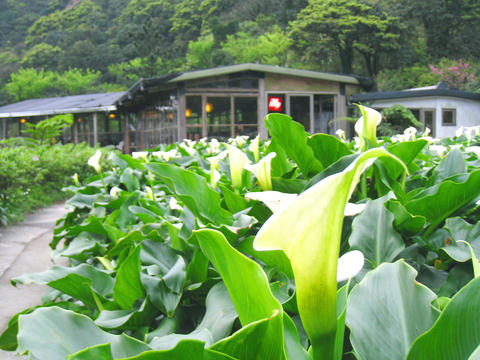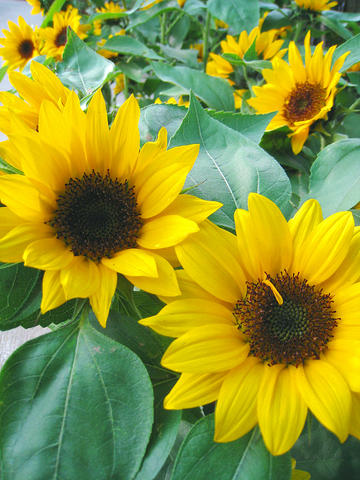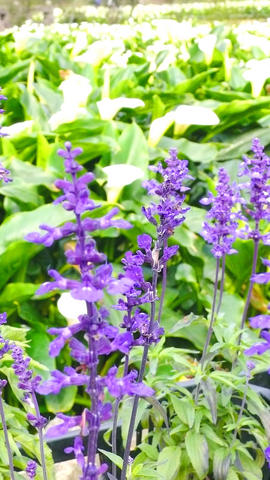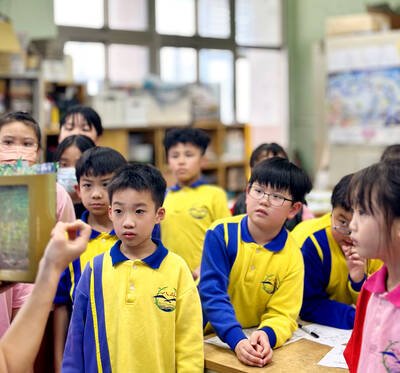In a sea of calla lilies, young couples banter while picking bunches of the white, long-stemmed flowers. Grandparents take a tea break on shady patios and watch moms and dads chase after their children. The Calla Lily Festival has made its annual return to Zhuzihu, or Bamboo Lake (竹子湖), in an event that routinely draws huge crowds to the secluded valley to pick lilies, enjoy a pot of tea or coffee, and eat local produce while admiring the fields of white blossoms.
Located in Yangmingshan National Park (陽明山國家公園), Bamboo Lake derives its name from the slopes of bamboo that cover the hillsides in this area. Because of its moist, cool air, this mountain valley is one of the few places in Taiwan where calla lilies thrive. More than 30 calla lily farms are located in the Dinghu (頂湖) and Xiahu (下湖) areas of Zhuzihu, and 15 of these will open their doors to visitors during the festival, which starts on Tuesday.
During the festival, Calla Lily Boulevard (海芋大道) becomes a car-choked road where it passes through Xiahu. Here, the road is flanked by restaurants, street peddlers and food stands hawking fruit, vegetables and snacks. The atmosphere here is little different from what you might find at any of the country's more popular tourist spots.

PHOTO: HO YI, TAIPEI TIMES
The bustle fades as one steps through the gates into a calla lily farm. Admission is usually NT$100 per person, and this allows you to pick a bouquet of eight flowers. Some establishments remain open until May, when African lilies and hydrangeas begin to blossom, followed by sunflowers in the summer.
"When calla lilies begin to flower in January and February, cherry blossoms are in full bloom, so the area has a spring feel. From February to March, the flowers look like fair damsels who will reach their full blossom in April," said a spokesman for the Beitou Farmer's Association (北投區農會), one of the festival organizers.
Travel further up the circular, winding route of Zhuzihu Road (竹子湖路), which connects the farms, to reach Dinghu, which is nestled between the Datun (大屯) and Qixing (七星) mountains. This area offers a more secluded setting. There are fewer restaurants and vendors, but the coffee shops here provide an unobstructed view of the steaming volcanic fissure of Xiaoyoukeng (小油坑).

PHOTO: HO YI, TAIPEI TIMES
Musical performances are scheduled to be held at different calla lily farms every Saturday and Sunday at 2pm. Light fixtures have been set up in the valley to extend the festival's activities until 8pm. Evening performances will take place at the Miao Bang Calla Plantation (苗榜海竽園), one of the oldest and largest calla lily farms in the area, and Hua Chih Yu Natural Garden (華之友自然景觀農園), a solitary establishment in the hot-spring village of Matsao (馬槽), which offers a great view of the calla lily fields.
For those interested in exploring the area around Bamboo Lake, tours are available at 10:30am and 2pm each Saturday and Sunday and depart from the entrance to Calla Lily Boulevard, where Zhuzihu Road and the Yangjin Highway (陽金公路) intersect.
Scheduled activities also include a photo contest (for more information, go to www.photo.org.tw), and a group wedding sponsored by the city government on April 27 that takes advantage of an environment that is an ideal backdrop for wedding photos.

PHOTO: HO YI, TAIPEI TIMES
Bamboo Lake accounts for nearly 90 percent of Taiwan's total production of calla lilies each year and has become one of the country's most popular tourist venues. When it was first grown here commercially in the 1970s, the South African plant was particularly favored as a flower for funerals. The area under cultivation has increased considerably in recent years, from around two hectares in 1999 to more than 13 hectares today, according to Wang Wen-an (王文安), head of the promotion and education section of the Beitou Farmer's Association.
The festival at Bamboo Lake is part of the Taipei City government's official promotion of agritourism, which began in 2002. The event now attracts more than half a million visitors each year and pumps over NT$140 million into the local economy, considerably more than the NT$30 million generated by flower sales alone.
Wang said there are many reasons why the event has been such a successful combination of agriculture and tourism: "Calla lilies are not fragile flowers. They aren't afraid of cold or dampness. From a farmer's perspective, the flower is easy to tend and blossoms over a period that can last for up to five months. From the tourism perspective, the flower creates a unique gardening vista with a palette of white, green and yellow. It creates a scene that is simple and elegant."
Traffic restrictions are imposed on weekends and national holidays between 9am to 5pm around Zhuzihu Road throughout the duration of the festival. Visitors are strongly advised to take public transportation to avoid traffic jams. Festivalgoers can take bus numbers 126 through 129 and 108 through 111 to Yangmingshan and then transfer to the Small 9 (小9號) or No. 131 bus to Zhuzihu. For more information, go to the event's official Web site at www.ed.taipei.gov.tw/calla-2008.

May 26 to June 1 When the Qing Dynasty first took control over many parts of Taiwan in 1684, it roughly continued the Kingdom of Tungning’s administrative borders (see below), setting up one prefecture and three counties. The actual area of control covered today’s Chiayi, Tainan and Kaohsiung. The administrative center was in Taiwan Prefecture, in today’s Tainan. But as Han settlement expanded and due to rebellions and other international incidents, the administrative units became more complex. By the time Taiwan became a province of the Qing in 1887, there were three prefectures, eleven counties, three subprefectures and one directly-administered prefecture, with

It’s an enormous dome of colorful glass, something between the Sistine Chapel and a Marc Chagall fresco. And yet, it’s just a subway station. Formosa Boulevard is the heart of Kaohsiung’s mass transit system. In metro terms, it’s modest: the only transfer station in a network with just two lines. But it’s a landmark nonetheless: a civic space that serves as much more than a point of transit. On a hot Sunday, the corridors and vast halls are filled with a market selling everything from second-hand clothes to toys and house decorations. It’s just one of the many events the station hosts,

Through art and storytelling, La Benida Hui empowers children to become environmental heroes, using everything from SpongeBob to microorganisms to reimagine their relationship with nature. “I tell the students that they have superpowers. It needs to be emphasized that their choices can make a difference,” says Hui, an environmental artist and education specialist. For her second year as Badou Elementary’s artist in residence, Hui leads creative lessons on environmental protection, where students reflect on their relationship with nature and transform beach waste into artworks. Standing in lush green hills overlooking the ocean with land extending into the intertidal zone, the school in Keelung

Taiwan Power Co (Taipower, 台電) and the New Taipei City Government in May last year agreed to allow the activation of a spent fuel storage facility for the Jinshan Nuclear Power Plant in Shihmen District (石門). The deal ended eleven years of legal wrangling. According to the Taipower announcement, the city government engaged in repeated delays, failing to approve water and soil conservation plans. Taipower said at the time that plans for another dry storage facility for the Guosheng Nuclear Power Plant in New Taipei City’s Wanli District (萬里) remained stuck in legal limbo. Later that year an agreement was reached